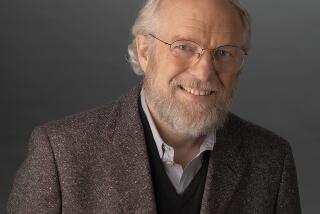Adobe’s Brick-Solid Partnership Faces Its Toughest Test Yet
MOUNTAIN VIEW, Calif. — In an industry where few partnerships have withstood the test of time, Adobe Systems Inc. co-founders John Warnock and Charles Geschke are an anomaly. Since 1978, when Geschke hired Warnock to work with him at Xerox’s famed Palo Alto Research Center, the two bearded computer scientists have set ego aside and together developed much of the software that has built the desktop publishing industry.
Adobe Systems, which Warnock and Geschke founded in 1982, has succeeded where nearly every other PC software company has failed: It faced Microsoft head-on and came out on top, establishing its own technology as the industry standard.
But now Warnock and Geschke are facing the most formidable challenge of their long partnership: They must cope with the sudden changes wrought by the Internet while simultaneously curing a bad case of indigestion caused by an acquisitions binge.
In early January, Adobe announced that it had lost $11.8 million for the fiscal quarter ended Dec. 1, a disclosure that sent its stock price tumbling $13.50, or 23%, to $45 per share in a single day. It closed Friday at $32.12 a share. Many analysts believe that, while cost cutting and other conventional measures can solve the short-term problems, the Internet riddle will not be solved so easily.
Warnock, normally reserved, becomes animated when talking about the subject, his pale blue eyes flickering with intensity. “There’s no chance we won’t dominate the Internet,” he contends. “Adobe’s success is that we have not ignored 500 years of graphic-arts history. That’s a mistake being made by the computer industry.”
With a product called PageMill, which makes it possible to quickly and easily create visually appealing “pages” for the part of the Internet known as the World Wide Web, Adobe hopes to carve out a role as a key vendor of Internet tools.
And with Acrobat, a technology that makes it possible to exchange fully formatted documents among many different types of computers, Adobe hopes to establish a standard for World Wide Web documents that are more elaborate and sophisticated than those displayed according to the simple language known as HTML.
*
Certainly, Warnock and Geschke have an impressive record when it comes to anticipating what will be important in publishing. When they were still at PARC, they began working on PostScript, a piece of software that makes it possible for a printer to understand and reproduce a complex document created on a computer.
The utility of such a technology was anything but obvious at the time--neither the desktop computers nor the printers of the day were generally capable of taking advantage of such software--and they spent two years on PostScript only to see Xerox ignore it.
“We spent two years of our lives going to meetings,” Warnock recalls. “Chuck and I were totally frustrated. One day, I went to Chuck’s office and said, ‘We can’t continue to live in the world’s best sandbox.”
And so they left to launch Adobe. Because Warnock had briefly worked at a start-up and Geschke had spent his entire career in research, it was decided the Warnock would be chief executive and Geschke president. “I said, ‘This might not work long term, but since I’ve done it before, I should probably be chief executive,’ and we’ve never talked about it again,” Warnock recounts.
The original plan called for Adobe to bundle its software with printers purchased from third parties, a rather ambitious plan for a start-up with limited resources. Warnock and Geschke found little interest among Silicon Valley venture capitalists, but they got help from Warnock’s graduate advisor at the University of Utah--David Evans, a highly regarded computer scientist who is considered the father of the supercomputer.
Evans called a San Francisco investment banker, William Hambrecht. “I wasn’t overly impressed with their business plan, but my real mentor in this business was Dave Evans,” Hambrecht said of that time. “Dave called me and said, ‘C’mon, these guys are real good.’ ”
Steve MacDonald, Adobe’s first sales vice president and a recruit from Hewlett-Packard, recalls the painstaking progress of the early days, when Geschke and Warnock were writing most of the software themselves.
“One day I heard all this shouting and screaming,” MacDonald said. “I thought, ‘Finally they’ve succeeded in getting a page with different typefaces on it.’ I ran back to where they were sitting and saw that they were excited because they had gotten the printer to spit out one little black square.
“I thought, ‘Oh my god, I left H-P for this?’ ”
But soon the company was making money, and the big breakthrough came in 1984, when Warnock received a call from Apple co-founder Steve Jobs. The then-new Macintosh computer turned out to be the perfect piece of equipment for desktop publishing, and PostScript was a crucial piece of software. Together, Apple and Adobe created desktop publishing.
And Geschke and Warnock continued to build their remarkable partnership. Although Warnock speaks softly and appears shy, his quiet manner masks his often strong opinions. Among Adobe insiders, he is known as the more volatile. When Apple, irritated with the high prices Adobe was charging for PostScript, teamed up with Microsoft in 1989 to challenge its longtime partner, Warnock, choking back tears, all but accused Apple of betrayal at an industry conference.
“Jean-Louis Gassee had it out for Adobe,” Warnock says today of Apple’s former research and development chief. “He was jealous of the relationship that Adobe had with Steve Jobs, and so he struck a deal with the real devil in Redmond.”
Gassee says there was nothing personal in his decision to look to Microsoft for similar technology. It was purely economics.
“We became overly protective of our position,” Geschke admits. “That opened us up to what happened. It was a good lesson, but a painful one.” Eventually, Adobe and Apple patched up their alliance, and Microsoft’s rival product, TrueType, never caught on.
*
Although Geschke is more gregarious than Warnock, he is also the more even-tempered. He once studied to become a Jesuit priest, and a profanity-laced phone call to Pacific Gas & Electric when the company’s power was accidentally shut off was so out of character that it’s become a part of Adobe folklore. “I don’t think I’ve ever seen Chuck use that kind of language before,” Warnock said with a chuckle. “He’s a gentle soul.”
Jobs said they are a perfect complement.
“John is like me--more emotional, more inclined to wear his feelings on his sleeve,” said Jobs, a longtime friend. “Chuck’s more controlled, stable and more even.”
While some portray Warnock as the visionary and Geschke the pragmatist, both men and those who know them say that misrepresents their relationship.
“There’s this notion among people outside the company that John gets all the ideas and I focus on running the company,” Geschke said. “People like to compartmentalize. If they don’t have a place to put you, then the world isn’t in order. But the truth is it really is a collaboration.”
“The way they work was confusing to me initially,” said former Adobe marketing vice president Deb Triant, who left the company last year to become chief executive of software start-up Checkpoint. “On any issue, I would have to check with both of them. ‘John and Chuck’ becomes one word to people at Adobe.
“It’s one of the really rare cases of power-sharing in the Valley,” Triant said.
It’s also an extremely close friendship, one that helped see both men through a terrifying 1991 incident in which Geschke was kidnapped from Adobe’s parking lot. He was held for five days as the kidnappers demanded $650,000 in ransom and Warnock worked with law enforcement authorities on behalf of the family. He was released unharmed, and the kidnappers were quickly arrested.
“If there was anyone I would have wanted to counsel [Geschke’s wife] Nancy to get me back, it would have been John,” he said.
Compared with the trauma of a kidnapping, of course, Adobe’s current difficulties seem minor. But Warnock and Geschke will need to be resourceful.
Adobe has over the years expanded its reach: Illustrator creates graphics for electronic documents, and Photoshop transforms photographs into computer images and enables artists to manipulate them. Two years ago, Adobe bought Aldus, a Seattle-based maker of page layout software. The resulting growth has brought problems, including bloated overhead, and exposed lingering weaknesses in Adobe’s marketing.
Indeed, the company has always tended to believe that good technology will find customers. But Acrobat, considered a remarkable technological breakthrough, has been slow to catch on because it wasn’t marketed properly.
“It was introduced as a technology and not a solution,” said a market watcher who declined to be named. “People thought it was cool, but they didn’t know what to do with it and so they didn’t buy it.
“Acrobat would be perfect for publishing on the Internet, but you never hear of it that way,” she adds. “As for HTML, there is this feeling that it is a limited technology, and although it is, it has momentum and it won’t be easily dislodged.”
But others believe it is a mistake to underestimate Adobe.
“What you have to remember about Adobe is that it stood up to Microsoft and lived to tell about it,” Jobs said. “There aren’t many who can say that.”
More to Read
Inside the business of entertainment
The Wide Shot brings you news, analysis and insights on everything from streaming wars to production — and what it all means for the future.
You may occasionally receive promotional content from the Los Angeles Times.










